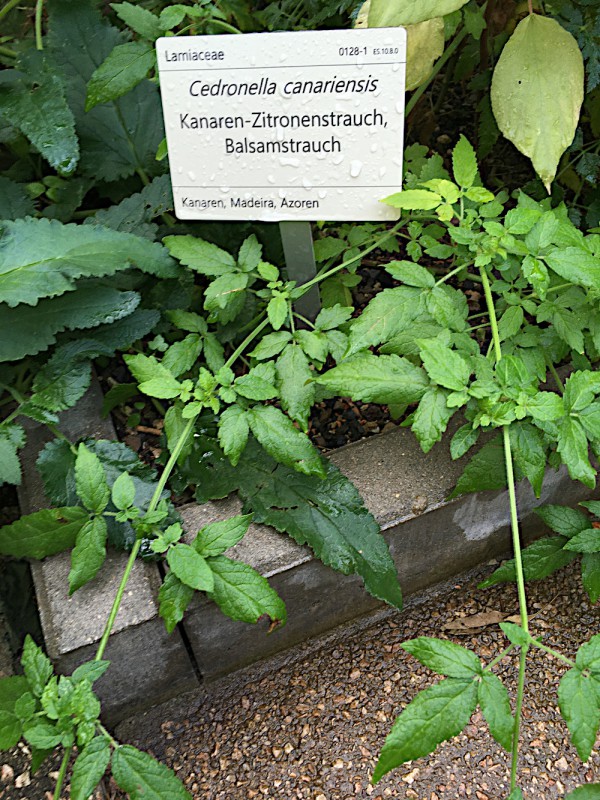Cedronella canariensis (L.) Webb & Berthel. syn. Dracocephalum canariense L.; Cedronella triphylla Moench - Lamiaceae - canary balm, the des canaries (span.), Kanaren-Zitronenstrauch, Balsamstrauch
Perennial plant, up to 1m high, native to the Canary Islands (Tenerife, La Gomera, Madeira) and Azores, naturalized elsewhere (South Africa, St. Helena, New Zealand, California); leaves lemon-like scented when brushed.
„The distinctive feature of these plants is the compound leaves consisting of 3 leaflets, unusual in the Lamiaceae, which usually have simple leaves. The leafy stems terminate in dense, short spikes of flowers with tubular 2-lipped white or pink flowers. The genus name is a diminutive of Cedrus, though the only connection between this herb and the large conifers of Cedrus is a vaguely similar resinous scent of the foliage.“ https://en.wikipedia.org/wiki/Cedronella
„The essential oils of Cedronella canariensis (L.) Webb et Berth, ssp. canariensis and ssp. anisata from Tenerife, La Gomera, Madeira and from a location in South Africa were analyzed in detail by GC, GC-EIMS, GC-CIMS, MID, SC and 13C-NMR. About 210 (ssp. canariensis) and 257 (ssp. anisata) compounds have been identified or at least partly characterized, with monoterpene ketone pinocarvone (>50%) as the most abundant compound of the oil of ssp. canariensis and methyl chavicol (>80%) as the main constituent of the oil of ssp. anisata. The latter was not identified in the ssp. canariensis. For both subspecies, two morphologically different formae were, f. glabra and f. pubescens.“
The essential oil of ssp. canariensis contained also more of β-pinene (10-26%) and limonene (0.6-1.1%), two of these oils also neral/geranial (0.5-0.7%).
[Engel, Ralf, Adolf Nahrstedt, and Franz-Josef Hammerschmidt. „Composition of the Essential Oils of Cedronella canariensis (L.) Webb et Berth, ssp. canariensis and ssp. anisata f. glabra and f. pubescens.“ Journal of Essential Oil Research 7.5 (1995): 473-487]
„Cedronella canariensis is a lemon-scented species of the family Lamiaceae endemic to the Canary Islands where it is used in the traditional medicine to prepare infusions or inhalations for anti-catarrhal, tonic, diuretic, hypoglycaemiant, hypotensive, anti-inflammatory and decongestant of the respiratory tract… The oil… was characterised by pinocarvone (58.0%) and β-pinene (10.8%) as the major constituents, being typical of the chemotype ‘canariensis’. Noteworthy was the cytotoxic activity of the oil against the tumour cells examined, with IC50 values of 4.3, 7.3 and 11.4 μg/mL on A375, MDA-MB-231 and HCT 116 tumour cells, respectively, as well as the scavenging activity against the ABTS radical (IC50 of 10.5 μg/mL).“
[Zorzetto, Christian, et al. „Antioxidant activity and cytotoxicity on tumour cells of the essential oil from Cedronella canariensis var. canariensis (L.) Webb & Berthel.(Lamiaceae).“ Natural Product Research 29.17 (2015): 1641-1649]

Cedronella canariensis, Gruson Gewächshäuser Magdeburg (2022)
CC BY-SA 3.0, Author: Andreas Kraska
